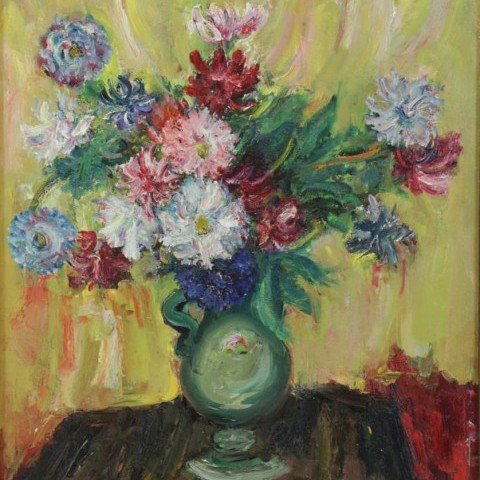Zucker was very much an international artist. He was born in Radom, Poland in 1900. As a youth he went to Palestine to study at the Bezalel Art School in Jerusalem. In 1917 he joined the British Royal Fuesiliers under the leadership of General Allenby to liberate Palestine from the Turks. After the war he studied art in Paris at the Academie Julian. He emigrated to the U.S. in 1922 and continued his art studies at the National Academy of Design. He supported himself by designing jewelry. In 1925 he returned to Paris and studied at the Academie de la Grande Chaumier et Colarossi. During the Depression he worked for the WPA.
Zucker's work, including landscapes, still-lives, and portraits painted in post-impressionist style were exhibited in numerous one-man shows in leading galleries and museums in New York, Paris, Tel Aviv, and other art centers. His work is represented in numerous museums and private collections, including the Hirshorn, the Museum of Modern Art in Paris, the Bezalel Art Museum in Jerusalem. A comprehensive study of Zucker's oeuvre was written by the dean of French art critics, Claude Roger-Marx of Figaro Litteraire. It is illustrated with 135 color and black and white plates.
While being Jewish figured extensively in Zucker's art and writings, he also took pride in being an "internationalist". "The art of painting in its highest expression is universal. People who respond to quality in art will understand the beauty and meaning of a 'good painting,' no matter where the canvas was created, in their own land or in a foreign land."(2) In the Spring, 1946 edition of The Menorah Journal, Zucker wrote:
Modern Jewish artists of talent and intelligence look critically at Jewish artists of the past who did sentimental pictures of bearded Jews or nostalgic Jewish scenes of the Old world. What really made those pictures bad art was not the subject, which was often beautiful, but the poor artistic execution. A serious Jewish painter is a painter of the world, and he is not bound to satisfy Jewish sentimentalist… The sudden upsurge of Jewish creativeness in the plastic arts came with great force. Perhaps because the past desire for expression in paintings and sculpture was frustrated through past generations of religious tabu [sic], Jewish art of today contains the fire of the flaming bush.(3)
Zucker maintained homes in Paris and New York, and spent considerable time painting in Mexico, Portugal, Greece, and Israel. He died in New York, March 18, 1981.

